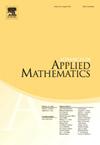Binary sequences meet the Fibonacci sequence
IF 1.3
3区 数学
Q3 MATHEMATICS, APPLIED
引用次数: 0
Abstract
We introduce a new family of number sequences , governed by the recurrence relation where is a sequence with values . Our study focuses on the properties of the sequence of quotients and its set of values for various u. We give a sufficient condition for finiteness of and automaticity of , which holds in particular when u is the famous Prouhet-Thue-Morse sequence. In the automatic case, a constructive approach is used, with the help of the software Walnut. On the other hand, we prove that the set is infinite for other special binary sequences u, and obtain a trichotomy in its topological type when u is eventually periodic.
二进制序列满足斐波那契序列
我们引入了一类新的数列(f(n))n∈n,由递归关系f(n)=af(n−un−1)+bf(n−un−2)控制,其中u=(un)n∈n是一个值为0,1的数列。研究了不同u的商数列h(n)=f(n+1)/f(n)及其值集V(f)={h(n):n∈n}的性质,给出了V(f)有限和(h(n))n∈n的自动性的充分条件,特别是当u是著名的prouheet - thue - morse数列时。在自动案例中,在软件Walnut的帮助下,采用了一种建设性的方法。另一方面,我们证明了集合V(f)对于其他特殊的二值序列u是无限的,并得到了当u最终为周期时其拓扑类型的三分法。
本文章由计算机程序翻译,如有差异,请以英文原文为准。
求助全文
约1分钟内获得全文
求助全文
来源期刊

Advances in Applied Mathematics
数学-应用数学
CiteScore
2.00
自引率
9.10%
发文量
88
审稿时长
85 days
期刊介绍:
Interdisciplinary in its coverage, Advances in Applied Mathematics is dedicated to the publication of original and survey articles on rigorous methods and results in applied mathematics. The journal features articles on discrete mathematics, discrete probability theory, theoretical statistics, mathematical biology and bioinformatics, applied commutative algebra and algebraic geometry, convexity theory, experimental mathematics, theoretical computer science, and other areas.
Emphasizing papers that represent a substantial mathematical advance in their field, the journal is an excellent source of current information for mathematicians, computer scientists, applied mathematicians, physicists, statisticians, and biologists. Over the past ten years, Advances in Applied Mathematics has published research papers written by many of the foremost mathematicians of our time.
 求助内容:
求助内容: 应助结果提醒方式:
应助结果提醒方式:


